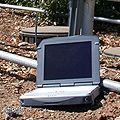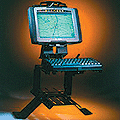|
Advantech UTC-515
Intel Atom-based "Ubiquitous Touch Computer" for interactive self-service applications
is very solid, quick, versatile, and well designed.
(by Conrad H. Blickenstorfer)
The Advantech UTC-515 is a specialized all-in-one panel computer with a 15.6-inch wide-format touch screen. Though it looks a bit like a cross between an iPad and a small version of an Apple iMac, the purpose of the UTC—which stands for Ubiquitous Touch Computer—is entirely different. Advantech designed the line (there are both larger and smaller versions as well) as display systems and touch-based LCD panels for self-service and promotional applications in different areas such as self-ordering, virtual receptionist, intranet access, trade shows, retail, etc. Potential applications are endless.
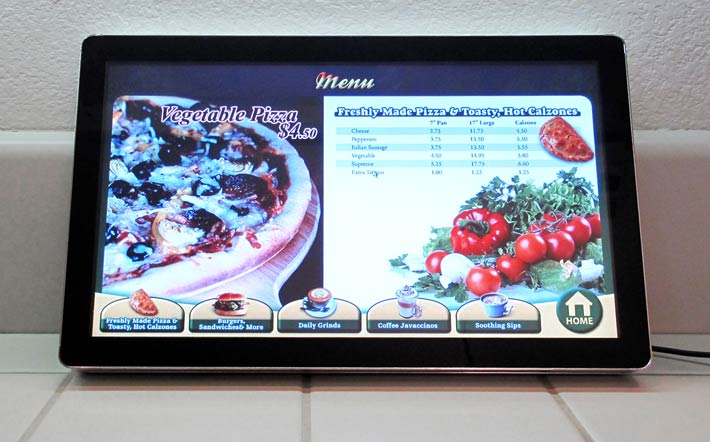
A closer look at the Advantech UTC-515
As far as design and technology go, the UTC-515 differs from generic industrial panels in its elegant, slim design, flush-mount wide-format display, and ability to be used stand-alone and not just mounted into panels. The display measures 15.6 inches diagonally with a 16:9 aspect ratio default resolution of 1366 x 768 pixel, which means it is well-suited for 720p HD video. The UTC-515 comes standard with a resistive 5-wire touch screen. A multi-touch digitizer is optionally available for the larger UTC-520 model (see our review of the UTC-520), but isn't listed for the UTC-515. There is no fan and the unit operates silently and without heating up at all.
The whole device measures 15.1 x 9.3 inches and is just 1.6 inches thick. Weight is a bit over nine pounds. The mechanical design has the cut-outs, indents and screwholes required for mounting on numerous Octanorm exhibition systems products as well as on standard 100 x 100 mm VESA mounts. Advantech also offers its own series of stands for the UTC-515 (see here).
Despite its slender design, things aren't too cramped inside. Like the larger UTC-520, the UTC-515 is heavily modularized, with a small and very compact system board at the center and a variety of subsidiary boards handling additional functionality—very much an embedded systems approach. Below you can see what the UTC-515 looks like inside once its steel backplate is removed.
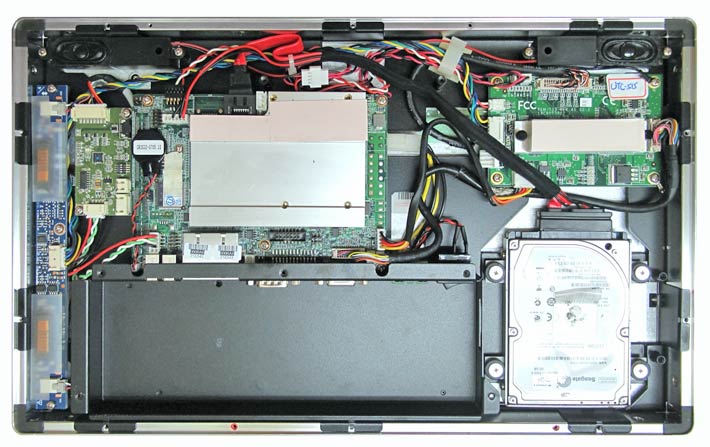
Not visible in the picture is the unit's CF Card slot that can be used to accommodate a solid state disk instead of, or in addition to the hard disk. Also not visible is the mini-PCIe slot that's meant to be used for an optional WiFi module. Both are on the bottom side of the small system board where you also find the sole 200-pin SO-DIMM DDR3 800MHz memory slot. The 2.5-inch hard disk sits in a rubber-mounted caddy. Our review unit came with a 160GB Seagate Momentus spinning at 5,400 rpm. A 250GB disk is also available. Note the two small rearward facing speakers and the heat spreaders on the system and subsidiary boards that dissipate heat to the housing via conductive materials.

All connectors and controls are concentrated in a single recessed downward-facing I/O block. You get two USB ports, a DB9 serial port, a VGA video port, two RJ45 LAN jacks, the power switch, and the power plug. The way the UTC-515's electronics are arranged and organized represents embedded systems design at its finest: take whatever components you need for a given task, then modularize things for configurability, scalability, reliability, and ease of service.
As far as peripheral options go, Advantech offers a "flexible peripheral series" for UTC devices that includes a camera, an RFID reader, a smart card reader, and a mag card reader.
Dual-core Atom power
When we reviewed an early production model of the larger Advantech UTC-520 in late 2010, it was one of the first products we've seen using Intel's dual-core Atom D510 processor. That chip was introduced in December of 2009 as an economical solution for low-end desktop computers. As a result of its intended purpose, the Atom D510 had a TDP (thermal design power) rating of 13 watts, which was a lot more than the roughly two watts the first and second generation N270/N450/Z5xx Atom chips drew. Since devices like these touch systems will always be plugged in (they don't have internal batteries, though a backup would come in handy for potential power failures), the higher—albeit still quite low—power draw makes no difference, especially since the unit's heavy metal housing serves as a very effective heat sink.
What has changed since our first evaluation of the UTC-520 is that the UTC-515 is now using a slightly quicker 1.8GHz Intel Atom D525 processor. The chips are essentially the same, but the newer D525 can use faster and more energy-efficient DDR3 memory. Our review UTC-515, though, still had the older D510 chip and DDR2 memory.
We still ran our standard separate sets of performance benchmarks (Passmark and CrystalMark), and compared the results with those of a variety of other Advantech boards and systems we had benchmarked earlier. The numbers are as follows:
|
PASSMARK
|
UTC-515
|
UTC-520
|
PIT-1501W
|
PPC-157T
|
ARK-3399
|
ARK-DS303
|
SOM-6760
|
|
Intel
|
Atom
|
Atom
|
Atom
|
Core 2 Duo
|
Core Duo
|
Atom
|
Atom
|
|
Intel
|
D510
|
D510
|
Z530
|
T7400
|
L2400
|
N270
|
Z530
|
|
Product type
|
Touch terminal
|
Touch terminal
|
Touch terminal
|
Panel PC
|
Industrial PC
|
Digital Signage
|
COM-Micro
|
|
Clock speed
|
1.66GHz
|
1.66GHz
|
1.6GHz
|
2.16GHz
|
1.4GHz0
|
1.6GHz
|
1.6GHz
|
|
Thermal Design Power
|
13.0 watts
|
13.0 watts
|
2.3 watts
|
34.0 watts
|
15.0 watts
|
2.5 watts
|
2.3 watts
|
|
CPU Mark
|
512.4
|
512.9
|
244.4
|
1292.1
|
847.5
|
252.6
|
315.6
|
|
2D Graphics Mark
|
153.8
|
173.8
|
108.3
|
285.8
|
145.0
|
158.7
|
207.2
|
|
Memory Mark
|
235.6
|
245.2
|
215.3
|
552.3
|
264.9
|
227.7
|
191.6
|
|
Disk Mark
|
261.1
|
431.3
|
162.1
|
459.6
|
10.1
|
459.4
|
70.7
|
|
3D Graphics Mark
|
12.1
|
12.4
|
18.3
|
37.8
|
29.5
|
77.3
|
19.6
|
|
Overall PassMark
|
256.0
|
294.7
|
154.5
|
584.7
|
302.4
|
232.6
|
137.3
|
|
CRYSTALMARK
|
UTC-515
|
UTC-520
|
PIT-1501W
|
PPC-157T
|
ARK-3399
|
ARK-DS303
|
SOM-6761
|
|
ALU
|
10772
|
11309
|
5323
|
19311
|
12971
|
5409
|
5376
|
|
FPU
|
9663
|
9347
|
4678
|
22560
|
15353
|
4671
|
4667
|
|
MEM
|
7709
|
7778
|
3853
|
10867
|
6407
|
4223
|
3667
|
|
HDD
|
7357
|
7087
|
5058
|
8231
|
3631
|
8221
|
2702
|
|
GDI
|
2592
|
2270
|
2321
|
4679
|
2403
|
2158
|
2427
|
|
D2D
|
3685
|
3693
|
859
|
3015
|
2444
|
2230
|
1009
|
|
OGL
|
723
|
711
|
317
|
2272
|
825
|
684
|
505
|
|
Overall CrystalMark
|
42501
|
42195
|
22409
|
70935
|
44034
|
27596
|
20353
|
The results are quite good. The Atom D510 produces far better numbers than systems based on the popular Atom N270/280 that was used in tens of millions of first generation netbooks, or the Atom Z530 which is still quite popular in embedded and industrial systems. The D510-powered UTC-515 even came close to the performance figures of one of Advantech's Core Duo industrial PCs. It's no match for a standard voltage Core 2 Duo such as the T7400, but that's to be expected given that chip's higher clock speed and TDP.
Note that benchmarks are notoriously confusing when used to compare different processor platforms. And we don't have an explanation as to why the UTC-515 matched the UTC-520 in one benchmark suite, but not in the other. In our experience, the overall bottomline is usually a good predictor of real world performance. That is no different here: the D510-powered Advantech UTC-515 feels very quick and responsive and should have no problems handling the interactive media terminal functions it is designed for.
The display
In an interactive media terminal, display quality is very important, and the Advantech UTC-515's 15.6-inch LCD is up to the task. Its fairly strong 300 nits LED backlight (your average notebook computer has about 200 nits) makes the display crisp and bright. The very wide 170 degree horizontal viewing angle means you can look at the screen from extreme angles and still see it clearly. The vertical viewing angle is also very wide (160 degrees), but there are some color shifts when you look at the screen from extreme vertical angles. Since the UTC-515 will usually be mounted in a position conducive for easy viewing, the vertical color shift does not impact performance. However, if used in restaurants and other places where visuals matter, accurate color from all angles would be a good thing.
The LCD is recessed behind a protective front cover that extends flush across the entire surface. There is a black bezel around the LCD similar to that of an iMac. The surface is glossy, which can result in annoying reflections. It is some, but not very, prone to finger prints. Overall, though, this is an excellent display. Below are some of the applications Advantech envisions for UTCs:

And below are screen shots of some of the demo applications on the UTC-515. It's easy to see how such a device could be used in a restaurant, at a convention, in stores, hospitals, or numerous other places.
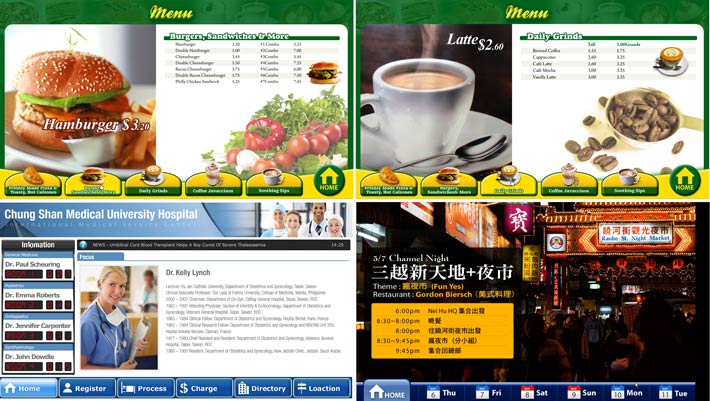
Ruggedness
While the UTC-515 is designed for stationary deployment in indoor environments, Advantech does submit some ruggedness specs. The unit can handle operating temperatures from 32 to 104 degrees, which is well beyond the range encountered in most self-service applications. It's also designed to handle a degree of vibration and shock, and the front panel offers IP54 protection, so if the device were to be mounted in a waterproof panel (the backside has cutouts and is not sealed against water), it can handle dust and rain. Overall, the UTC-515 is clearly an industrial-quality and exceedingly solid device.
The Advantech UTC-515
The UTC-515 is part of an interesting series of human-oriented, all-in-one, interactive digital touch terminals. Its bright 15.6-inch wide-format display is perfect for applications where people interact with a terminal, as opposed to larger format signage displays. Since it doesn't need a fan, the device is silent—important in many potential application settings. The Intel Atom processor is up to the task and fast enough for most conceivable applications. There are numerous mounting options as well as a number of data capture/access control peripherals such as RFID, Smart Card, and mag stripe.
Considering that in just the last few years, almost all airports and many other public places have replaced their ancient manual or mechanical information boards with digital signage and info terminals, and businesses the world over are seeking new and innovative ways to automate and improve service, the market for this technology seems very promising indeed. It is not clear what will and what will not be automated, but with the UTC-515, Advantech certainly has a competent and remarkably versatile hardware solution.
Advantech UTC-515 Specs:
| Added |
January 2012
|
| Type |
Touch computer/panel
|
| CPU Type |
Dual-core Intel Atom D510 with 2 x 512kb L2 cache
|
| Clock Speed |
1.66GHz
|
| Chipset |
Intel ICH8M
|
| BIOS |
AMI
|
| OS |
Windows XP/XPE, Windows 7, Embedded Standard 7, CE 6.0
|
| Memory |
DDR3 800MHz in 1 200-pin SODIMM socket
|
| Graphics Controller |
unknown
|
| VRAM |
unknown
|
| Expansion slots |
1 CF Card, 1 mini-PCIe
|
| Display |
15.6-inch TFT LCD with LED backlight, 170/160 degree viewing angle, 300 nits
|
| Resolution |
Default: 1366 x 768 pixel; scalar board allows resolution up to full 1080p HD (1920 x 1080)
|
| Digitizer |
Analog resistive 5-wire with USB interface
|
| LAN |
2 x 10/100/1000Base-T |
| SATA |
1 x 300 MB/s |
| Disk |
160GB 5400rpm Seagate Momentus
|
| SSD |
Optional SSD in CF Card slot
|
| USB |
2 x USB 2.0
|
| Serial |
1 x RS232 |
| Audio |
2 x 3 watts |
| Size |
15.1 x 9.3 x 1.6 inches
|
| Weight |
9.2 lbs.
|
| Operating Temp. |
32 to 104F
|
| Sealing |
IP54 front panel protection
|
| Price |
inquire
|
| Product page |
Advantech UTC-515 product page |
| Datasheet |
Advantech UTC-515 data sheet (PDF) |
| Product Ad |
Advantech 'Service is Just "One-Touch" Away' product line ad |
Advantech Corporation
38 Tesla, Suite 100
Irvine, CA 92618
Toll Free: 1-800-866-6008
Ph: 949-789-7178
Fax: 949-789-7179
ECGInfo@advantech.com
www.advantech.com
Advantech Co. Ltd.
No.1, Alley 20, Lane 26, Rueiguang Road
Neihu District, Taipei Taiwan 114, R.O.C.
Tel: 886-2-2792-7818
Fax: 886-2-2794-7301
www.advantech.com
|



